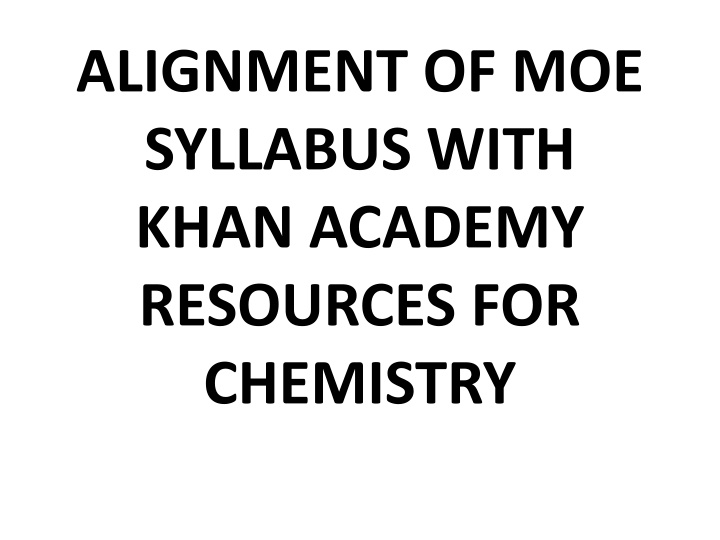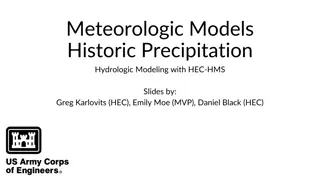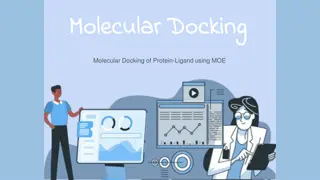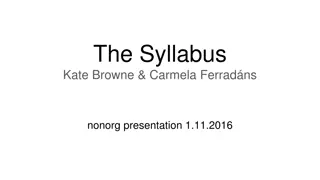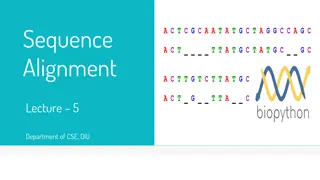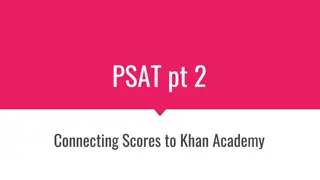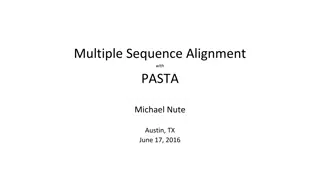Comprehensive Alignment of MOE Chemistry Syllabus with Khan Academy Resources
This comprehensive alignment showcases the correlation between the Ministry of Education (MOE) chemistry syllabus and the educational resources provided by Khan Academy. It covers various topics in chemistry such as the particulate nature of matter, atomic structure, chemical bonding, stoichiometry, energy changes, inorganic chemistry elements and compounds, and much more. This alignment aims to offer a structured approach to understanding fundamental chemical processes and phenomena in the context of high school chemistry education.
Download Presentation

Please find below an Image/Link to download the presentation.
The content on the website is provided AS IS for your information and personal use only. It may not be sold, licensed, or shared on other websites without obtaining consent from the author.If you encounter any issues during the download, it is possible that the publisher has removed the file from their server.
You are allowed to download the files provided on this website for personal or commercial use, subject to the condition that they are used lawfully. All files are the property of their respective owners.
The content on the website is provided AS IS for your information and personal use only. It may not be sold, licensed, or shared on other websites without obtaining consent from the author.
E N D
Presentation Transcript
ALIGNMENT OF MOE SYLLABUS WITH KHAN ACADEMY RESOURCES FOR CHEMISTRY
SCOPE OF CONTENT OF MOE/GES CHEMISTRY SYLLABUS THE SCOPE OF THE SYLLABUS IS TO OFFER CHEMISTRY REQUIRED TO PROMOTE AN UNDERSTANDING OF THE CHEMICAL PROCESSES TAKING PLACE ALL AROUND US.
SHS1 MOE KHAN ACADAMY Introduction to Chemistry Chemistry as a discipline Measurement of Physical Quantities Basic Safety Laboratory Practices Particulate Nature of Matter Structure of the Atom Periodicity Interatomic Bonding Intermolecular Bonding Hybridization and Shapes of Molecules Carbon-12 Scale Solutions Stoichiometry and Chemical Equations Nuclear Chemistry Solids and Liquids Gases and their properties History of atomic structure Periodic table Ionic, covalent and metallic bonds Introduction to intermolecular forces Hybridization and hybrid orbitals The mole and Avogadro's number Mixtures and solutions Chemical reactions and stoichiometry Nuclear Chemistry States of matter States of matter
SHS2 ENERGY AND ENERGY CHANGES MOE syllabus Khan Academy syllabus Enthalpy changes associated with exothermic and endothermic processes and energy diagrams for exothermic and endothermic processes Heat of formation Explanation of the term system and surrounding Energy and enthalpy Enthalpy and internal energy Measuring the enthalpy change using experiment Calorimetry and enthalpy Types of enthalpy changes Standard states and standard enthalpy of reactions Calorimetry and enthalpy Hess s law and application in Born Haber cycles. Hess s law and reaction enthalpy change. Hess s law examples Enthalpy of neutralization of an acid-base reaction. Bond energy Bond enthalpy and enthalpy of reactions
INORGANIC CHEMISTRY MOE syllabus Khan Academy syllabus Physical and chemical properties of period 3 (Na Cl) elements. Physical and chemical properties of compounds of Period 3. Thermal stability of the CO3-and NO3- of some metals. Experiment to compare the thermal stability of some trioxonitrate (IV) of some metals. Uses of silicon Physical properties of Group 17 elements Electron configurations and variable oxidation states of halogens. Reactions of halogens with water and alkalis
INORGANIC CHEMISTRY CONT. Acidic strength of hydrogen halides Ka and strength of acids Electron configuration of first row transition elements (21Sc 30Zn). Transition metals Properties of transition metals Catalytic properties of transition elements and their compounds Bonding in complex compounds Nomenclature of complex compounds Shapes of complex compounds i.e Tetrahedral, square planar, octahedral. Similarities and differences between transition and representative (main group) metals.
CHEMICAL KINETICS AND EQUILIBRIUM MOE syllabus Khan academy syllabus Meaning of Chemical Kinetics Introduction to chemical kinetics Monitoring the rate/speed of a chemical reaction. Factors that influence the rate of chemical reaction Temperature change and reaction rate Collision theory Deductions from experimental data and graphs on rate of reaction. Collision theory and rate of reaction Collision theory and activation energy. Experimental determination of rate law Transition theory and chemical reactions Collision theory and activation energy. The rate law Rate law Finding K and it s units Rate law and reaction order Orders of reaction Half life of a reaction Half life of first order reactions Examples of first order reactions Rate constant K and half life
Redox reactions and organic chemistry K h a n A c a d e m y MOE syllabus Oxidation reduction processes, oxidizing reducing agents Balancing redox reaction equations Redox titration Electrochemical cells Electrolytic cells Corrosion of metals Che mi st ry of c a rbon s Bonding in carbons Classification of organic compounds Identification of elements in organic compounds Separation and purification of organic compounds Oxidation reduction reactions Oxidizing reducing agents Balancing redox reaction equations Redox titration Electrochemical cells Electrolytic cells Found in AP chemistry and Organic chemistry. - Spectroscopy e.g. infrared, UV/Vis spectroscopy and NMR.
SHS3 CHEMISTRY, INDUSTRY, ENVIRONMENT AND BASIC BIOCHEMISTRY MOE SYLLABUS KHAN ACADEMY SYLLABUS The chemical industry Extraction of metals Extraction of crude oil and petroleum processing Environmental pollution Biotechnology Cement and its uses Fats and oils Macromolecules 1. Lipids (Biology) Proteins Macromolecules 2. Proteins (Biology) Carbohydrates Macromolecules 3. Carbohydrates (Biology) Synthetic polymers
